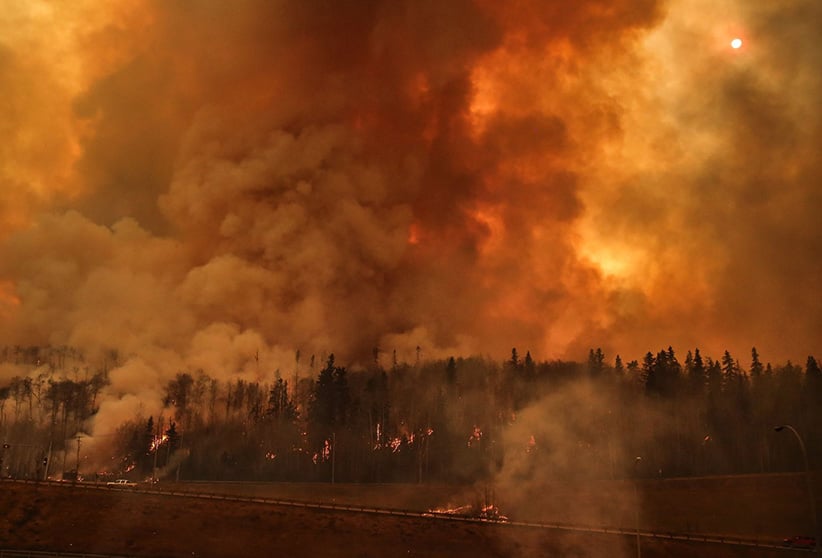How did Fort McMurray get out alive?
‘They were ready,’ says one fire expert who knows firsthand what it’s like to fight an unpredictable wildfire
Share

Jamie Coutts, fire chief of Slave Lake, Alta., is all too familiar with wildfire devastation. Five years ago, a third of his town was destroyed by an uncontrollable forest fire. This Wednesday, he stood in the Thickwood Heights area of Fort McMurray, watching “a bomber show—water bombing behind us,” he told Maclean’s, while taking a brief lunch break. The 2011 Slave Lake fire resulted in no casualties in the town’s population of 7,000 (a helicopter pilot died fighting the fire). As of Wednesday afternoon, that was also true in Fort McMurray where no casualties or major injuries had been reported after more than 80,000 residents, including 105 patients and clients of the local hospital, had been evacuated.
Given the apocalyptic images broadcast from the town—towers of fire lining highway 63, cars driving through a wall of grey smoke driving bumper-to-bumper—that seems nothing short of a miracle. According to those on the emergency services front line, such an outcome is the sum of a confluence of forces—from preparedness to luck. Devastation can spur action; after the Slave Lake fire, the Alberta Emergency Management Agency launched a province-wide emergency management exercise that helped pave way for response this week.
Related: What does it take to fight a fire like the one in Fort McMurray?
Coutts arrived in Fort McMurray at 1:30 p.m. Tuesday afternoon after a voluntary evacuation order had become mandatory, just before Premier Rachel Notley addressed the province: “Our focus is completely and entirely right now on ensuring the safety of people, of getting them out of the city,” she said. “There was a fully functioning emergency centre,” says Coutts. “They were ready.” RCMP patrolled the town. Fifteen residents cut off from town were picked up by aviation services.
Two biggest issues in evacuating without incident are logistics and communications, says Dr. Brian Schwartz, chief of communicable diseases, emergency preparedness and response with Public Health Ontario. This involves advanced training exercises between acute care services, paramedics, and mutual aid agreements to share resources. “We’ve come a long way in the last few years in our ability to predict and model what might happen,” says Schwartz, who is also associated with the federal Centre for Excellence of Emergency Preparedness. “We are also more proactive in how to evacuate. Whether it’s a toxic threat, nuclear event or wildfire, it’s a matter of doing risk-benefit analysis of evacuation compared to sheltering in place. Clearly in this case it’s not just smoke, it’s fire, whereas with a nuclear threat it’s shelter in place.”
Fire blew up in town with less than an hour’s notice, says Coutts, who notes that the community had been warned of the encroaching, surrounding fire for days. Forest fires are unpredictable in terms of scope, he says. “We didn’t expect it in Slave Lake, they didn’t expect it here. It was manageable in the morning; when we got here at 1:30, it was quite quiet. Then the wind changed direction a couple of times and picked up to 40 km/h and all of a sudden it’s not manageable. You can’t interpret what Mother Nature is going to do, not even the weather people can.”
At Wednesday’s press conference with the premier, it was reported no one in Fort McMurray refused to leave: “That doesn’t mean they’re not there but we were not getting those reports,” one government official said. Coutts reports being in the blazing Beacon Hill area yesterday where it was so hot he had to retreat behind the fire truck. “Fire had crossed the road, houses were on fire, and a woman jumped in her truck with her tiny baby and said, ‘Now I’m going to evacuate.’ ”
Related: Want to help those fleeing Fort McMurray? Here’s how.
There’s also no doubt luck played a role. And part of that could have been a function of the demographics underlying the industry town: the population’s median age of 31.7 (nearly a decade younger than the national average) making mobility easier. There’s also the fact that fire never blocked the single highway evacuees used to make the way south; roughly 10,000 people moved north. Flames crossed the highway but only in spots, says Coutts. “There were embers and hot pieces of tree that would blow across and spread because of the wind and how hot it is here, but there was never a risk of a wall of flame,” he says. “It’s a double divided highway; there are big ditches. Moving out, it was easy, those people kept moving; the danger is if you get stopped. Some big trucks broke down, which was a problem.” That’s not to say there wasn’t real and present danger, Coutts says, pointing to a part of town where a big hotel burned down and a gas station blew up. “Those areas were hot,” he says. “We drove through and you could feel the heat on the window, but you’re moving forward.”
An absence of widespread panic abetted exodus, though there were reports of people driving on sidewalks and landing in ditches. Coutts reports one bus driver tried to make it down the highway meridian. “Often people don’t panic as much and you think they will,” says Schwartz. “They’ll be deliberate and will work together—not blocking each other and getting in line. People summon the courage to just to do it.” Coutts speaks of the 95 per cent rule: “95 per cent are doing what they’re supposed to; five per cent are being obstinate and hampering the process,” he says. “Luckily the 95 wins out.” Fortunately, the odds were higher in Fort McMurray. We can only hope that remains the case.
